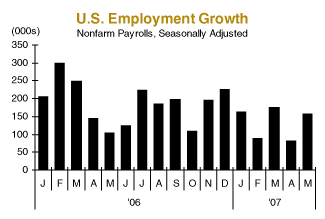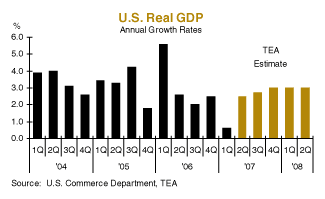|
June 6, 2007
Sweet Spot…Jobs
Written by Jeff Thredgold, CSP, President, Thredgold Economic Associates
U.S. employment gains in May nearly doubled those of April as the American economy shows more signs of rebounding from a sluggish first quarter 2007 growth pace. We expect the combination of solid job gains and stronger economic growth to continue.
The American economy added 157,000 net new jobs in May, nearly double the revised 80,000 net addition of the prior month. The 157,000 gain was slightly above the 140,000 rise expected by economists. Job gains during 2007’s first five months averaged 133,000 monthly, down 30% from the 189,000 average monthly increase in calendar year 2006. 
The May employment report also noted that the average work week rose from 33.8 hours to 33.9 hours. While seemingly insignificant, the rise is equivalent to another 300,000 rise in employment (The Wall Street Journal).
Steady…Steady
In addition, the nation’s unemployment rate remained at 4.5%, near the low of the past six years. The unemployment rate has remained steady in a range of 4.4%-4.6% over the past nine months.
Job creation during May took place entirely within the service-providing sector. The sector added 176,000 net new jobs, led by a rise of 54,000 jobs in education & health services. The leisure & hospitality sector added 46,000 net new jobs, while the professional & business services sector added 32,000 jobs. The government sector saw a net rise of 22,000 positions, while the retail trade sector lost 5,000 jobs.
The nation’s goods-production sector recorded a net decline of 19,000 jobs, with an identical decline in manufacturing employment, the 11th straight monthly decline. Most of the manufacturing losses were in the auto sector. Other economic data reported last week, however, provided a more optimistic outlook for the manufacturing sector in coming months (see below).
Construction employment was estimated as unchanged. Gains in commercial real estate employment likely offset losses in single-family residential construction.
The average hourly wage rose 0.3% (six cents) to $17.30. The rise of 3.8% in hourly wages over the past 12 months exceeds the 2.6% rise in the Consumer Price Index for the 12-month period ending in April.
A Goldilocks Economy
Recent employment data, combined with other indications of a U.S. economy appearing to rebound to a “not toooo hot, not toooo cold” growth pace, continues to support the Federal Reserve’s move to the sidelines in late June 2006.
Such growth expectations also support the view that the Fed is likely to remain on the monetary sidelines for additional months to come. The Fed is clearly pleased with the current level of employment growth and overall economic performance, with a view that the first quarter’s soft growth pace will not be repeated.
As one economist put it, “If you’re the Fed, the only danger right now is you might strain your arm patting yourself on the back.”

Sweet Spot…Growth
The bad news? U.S. economic growth during the January-March 2007 quarter was the weakest in more than four years...
The good news? Such a pathetic growth pace is widely expected to give way to a 2.2%-3.2% real (inflation adjusted) annual growth pace over the next nine months, with slightly stronger growth the consensus view for 2008…
During 2007’s first quarter, the U.S. economy recorded its slowest growth pace since 2002’s fourth quarter. The U.S. Commerce Department’s first revision of economic growth (gross domestic product or GDP) came in at a 0.6% real annual rate, less than half the 1.3% real annual growth estimate released in late April. Economists expected a slightly lesser revision to 0.8%. 
However, components of the report, combined with other economic data of recent days indicating stronger manufacturing and overall job growth prospects, suggest stronger growth over the balance of the year. In fact, various forecasts have current quarter growth at or above a 3.0% real annual rate.
Weakness in the nation’s housing and automotive sectors contributed to the first quarter’s soft growth pace. Strength during the first quarter was primarily found in the consumer spending area. Consumer spending, which accounts for roughly 70% of overall U.S. economic performance, rose at a 4.4% annual rate during the January-March period, after rising at a 4.2% pace during the prior quarter.
Growth Cutters
A decline in business inventories helped push the first quarter’s growth pace lower, as did rising imports. Each factor reduced first quarter growth by roughly 1.0% as compared to the prior quarter.
However, note that GDP is a measure of what is produced…not what is sold. The fact that inventories of goods actually declined in the first quarter strongly suggests that production levels will be boosted in the current and following quarters, leading to stronger overall economic growth.
At the same time, a closely-watched measure of manufacturing activity told a surprisingly strong story with its release on June 1. The Institute for Supply Management reported that its manufacturing index rose to 55 in May, the highest total in a year. The new order component within the index hit a 15-month high, while the production component rose as well.
Within Range
Better inflation news was also released in recent days. The core (excluding volatile food & energy prices) personal consumption expenditures (core PCE) report of June 1 noted that prices rose by 0.1% in the latest month.
More important to financial markets, the core rate has now risen 2.0% over the most recent 12-month period, the smallest rise in more than a year. The 2.0% rise was also the first time in many months that the rate fell within the 1.0%-2.0% “target range” assumed to be critical to Federal Reserve Chair Ben Bernanke. The core PCE is widely considered one of the most important inflation measures (if not THE most important) followed by the Fed.
…reasonable job growth…stronger growth with limited chance of recession…an improving manufacturing sector…and moderating inflation pressures…
…a nice mix in the eyes of the Fed in this 6th year of economic growth
Email this article to a friend
|
|
Subscribe to the Tea Leaf
Like what you just read? Have Jeff Thredgold’s Tea Leaf emailed to you free each week. Subscribe today.
|
|
|

“Tea”ser
Football is a mistake. It combines the two worst elements of American life…violence and committee meetings.
Send us a “Tea”ser of your own.

“Tea”stimonial
“Your presentation at our regional meeting was fantastic. I heard nothing but positive reviews from my group. This wasn’t the ‘usual’ economic presentation that all of us have seen many times. Your injection of humor and many interesting ‘fun facts’ kept the group engaged and interested.”
—Kevin B. Meeks, Senior Vice President, Regional Manager, KeyBank Real Estate Capital
More testimonials
Invite Jeff Thredgold to speak at your next conference, meeting, or client function
If you like the Tea Leaf, you’ll love Jeff Thredgold’s live presentations. Jeff takes your audience on a timely, engaging, and entertaining tour of the U.S. economy and financial markets. Debunking some of today’s most common economic myths, he offers a clear picture of how the American economy is really performing and what that means for the future of your finances.
|
